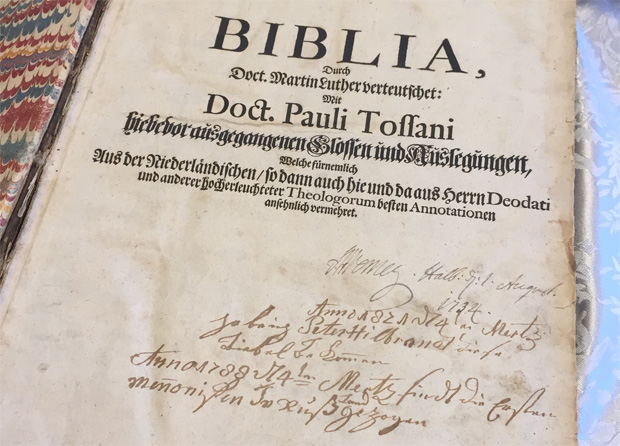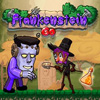Village News
Wieler Family Bible

At Mennonite Heritage Village (MHV), we collect and exhibit objects that help us tell the story of Russian-descendant Mennonites. I am very used to accepting family heirlooms into our collection, but I never imagined that MHV would accept a piece of my own family’s history during my tenure here.
For years I had been hearing about the Wieler Family Bible, which was in my grandparents’ possession, but somehow I always managed to forget about it when I was at my grandparents’ home (no doubt distracted by family and food). Finally, at the Easter gathering before last, my Grandpa Wieler decided it was time to bring out that bible. I thought it would be the size of a modern bible, maybe a hundred years old, so imagine my surprise when my grandfather walked into the kitchen carrying a book that was almost 18″ tall, 10″ wide, 4″ thick, and printed in 1716. He said that he and his surviving siblings were concerned about its future and asked me if a museum would want it.
The Wieler Family Bible was printed by Johann Detleffsen in Prussia (now Poland). The scriptures are Martin Luther’s German translation, with commentary by 17th century German theologian Paul Tossanus. Its black leather cover, embossed with the initials “F.A.W.” and the year 1734, is in remarkably good condition. Although stained in some spots with age and use, the rag paper the bible was printed on has ensured that the type and woodcuts are as crisp as the day they were printed.
The Wieler genealogy has been traced back to Peter Wieler (ca. 1737-1786), but he was born a generation after the bible was printed. Could “F.A.W.” be the initials of his father or grandfather? Could this really have been in the family for three hundred years? There are several inscriptions that may, when translated, shed some light on the matter. But they also complicate things, as one of the inscriptions on the title page seems to have been written by Peter Hildebrand (1754-1849), who wrote the first history of the Mennonite immigration to Russia. How did he get a hold of this bible?
The trail of ownership only picks up when the bible was already old. As far as I can tell, it came to Canada with my great-great-grandparents, Cornelius (1850-1924) and Margaretha (Klassen) Wieler (1846-1942), in 1875. They settled on the West Reserve, around what is now Winkler, in either Gnadenthal or Ebenfeld. They were excommunicated from their Old Colony congregation when they moved on to their own homestead shortly thereafter. They moved back and forth between North Dakota and Haskett, Manitoba, before settling in Walhalla, North Dakota. My great-grandparents, Jacob C. (1885-1967) and Katherina (Suderman) Wieler (1896-1973) moved back to Haskett for good in the mid-1920s.
The bible stayed in Walhalla until Cornelius, son of Cornelius and Margaretha, passed away in 1961. A friend of his gave the bible to my great-grandfather, Jacob C. Wieler. After his and Katherina’s deaths, the bible passed to their son, also Cornelius. After his death, it passed to his brother, my grandfather, Henry.
My grandfather passed away before he could sort out the bible’s future with his surviving siblings. But just last week my great-uncles Frank, Peter, and John Wieler and my great-aunt Jane (Wieler) Braun completed the donation paperwork. The Wieler Family Bible will now make its home at MHV, where its history will be documented and kept for future generations.




